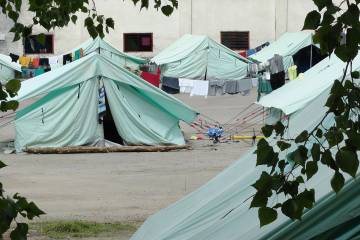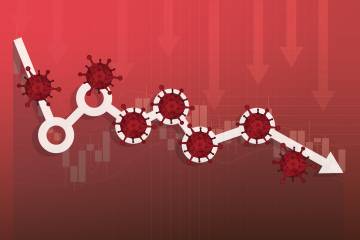The COVID-19 pandemic has disrupted many aspects of our daily lives, but its impacts are especially acute for people living with disabilities, who may struggle with challenges like finding reliable and safe in-home care or physically adapting to enhanced hand-washing guidance.
But the coronavirus outbreak has also created opportunities for more equitable inclusion after the pandemic ends, says Bonnielin Swenor, an associate professor of epidemiology and ophthalmology at the Johns Hopkins Wilmer Eye Institute and the Bloomberg School of Public Health.
The Hub spoke with Swenor, who studies the public health impacts of vision loss and disabilities, to learn more about how COVID-19 is impacting that community and how we can make sure its needs aren't ignored or overlooked. This conversation has been edited for length and clarity.
How might the pandemic affect those who have disabilities?
For people with disabilities, all the general challenges that come with the pandemic certainly apply, but there are additional barriers. The first is communication—getting information can be more difficult for people with vision, hearing, and even cognitive disabilities, as popular news sources may not be accessible, especially when information is changing quickly. I'm visually impaired and can attest to that. Keeping all of us informed is key to the COVID-19 public health response, but information is not always accessible to the disability community, leaving us sidelined.
The second barrier involves adopting recommended public health strategies, such as social distancing and washing hands. For example, frequent hand-washing is not always feasible for people with certain types of physical disabilities. As an epidemiologist, I know the value of these strategies, but public health policies often do not consider people with disabilities, leaving a gap in guidance. Those who have personal aides and caregivers also need to be considered, as they cannot participate in social distancing in the same way that others are.
The third, equitable access to health care, is a long-standing barrier worsened by COVID-19. This ranges from getting a coronavirus test to being seen in an emergency room. For instance, drive-up testing may be impossible if you rely on state mobility services. There are also existing barriers in health care settings that are exacerbated as the industry aims to meet the surge of COVID-19 cases. For example, the use of personal protective equipment, including masks, can make communication more difficult for patients with hearing loss.
Additionally, the allocation of medical resources is a concern. There's fear that medical resource allocation, including ventilators, may be discriminatory against patients with disabilities, and complaints have been filed in multiple states about these rationing policies. This issue echoes an underlying misconception that people with disabilities can't have a high quality of life and therefore the lives of disabled people may not be prioritized.
How is COVID-19 changing access to care and inclusion for those with disabilities and others?
It's changing it in a number of ways. There has been a shift toward telehealth for nonurgent medical visits. That has provided challenges but also future opportunities for the disability community. We must ensure that telehealth visits are accessible to patients with vision or hearing loss or other disabilities in order to maintain equity in health care delivery. If accessibility is prioritized as we make this change, a transition to telehealth could open the door to a more accessible health care system.
While there's a lot of pressure and certainly a high demand to meet the COVID-19 surge, it is still crucial to make sure that the disability community is being considered. It's truly a remarkable and challenging moment for our health system, but the needs of the disability community can't fall through the cracks. The issues of pre-pandemic care delivery only become more urgent in a time of crisis because people with disabilities have often not been considered in a disaster or pandemic planning. We need to learn from this crisis and ensure disability is part of future pandemic planning.
For those in the disability community who require in-home care or essential services when away from home, what steps can be taken to minimize the risk of spreading the coronavirus while still receiving necessary care and assistance?
People who use in-home care need to make sure that they have contingency plans for their care needs in case a caregiver becomes ill. Caregivers and community organizations should also consider changing their staffing to the best of their ability in order to minimize spread. For instance, instead of three rotating caregivers being assigned to an individual, assign one for a longer period of time. For people with a primary caregiver in the home, more flexibility in paid time off or sick leave can minimize exposure while also meeting the care needs of the individual. What's really important is to engage the individual and the disability community at the policy level.
In a moment when many providers have had to alter their operations due to the pandemic, what are ways to advocate for essential services and treatment for the disability community?
The best approach is to ensure that whenever we're talking about inequity or differences in the COVID-19 response, disability is part of the discussion. Many people with disabilities are at high risk of COVID-19, but their perspective is not being included in the efforts to address inequities in the response. This includes understanding the unique challenges of this community during this crisis.
We also need disability data. There is currently no systematic reporting of COVID-19 testing, infection, mortality, or outcomes by disability status. In recent weeks, important differences in this data by age, geographic location, underlying health condition, and race have emerged. These data have been critical for allocating resources and directing policies, as well as highlighting underlying disparities and elevating discussions around these health gaps. But for people with disabilities, an often-ignored health disparity population, we don't even get counted. And this is not just the case for COVID-19. Disability data is infrequently collected in this type of public health and medical surveillance, which limits opportunities to address disability inequities.
As the COVID-19 pandemic continues, what impact and legacy do you think it will have for those living with disabilities?
I'm an optimistic person, and though it can be hard to think positively right now, there is an opportunity to change how we include people with disabilities in this moment. COVID-19 has elevated that conversation, and the legacy should be a continued focus on disability disparities and constant efforts to address disability inequities.
As we all make substantial changes in our daily lives, such as working from home and adjusting how we connect to others, look to people with disabilities for guidance, as we have always used alternative strategies. We are the vanguards of resilience. My hope is that COVID-19 will bring more understanding, inclusion, and opportunity to the disability community.
Posted in Health, Voices+Opinion
Tagged health equity, coronavirus, covid-19










